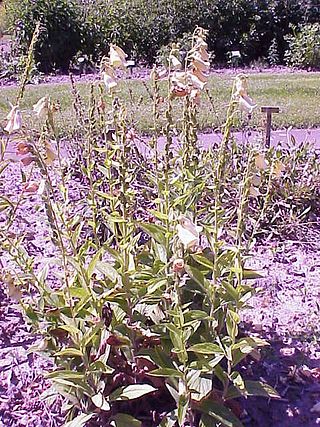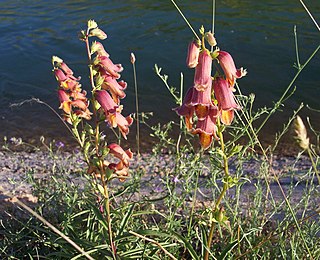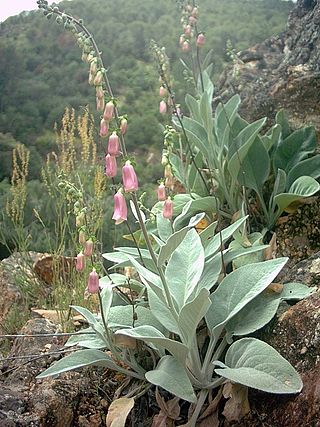
Cardiac glycosides are a class of organic compounds that increase the output force of the heart and decrease its rate of contractions by inhibiting the cellular sodium-potassium ATPase pump. Their beneficial medical uses include treatments for congestive heart failure and cardiac arrhythmias; however, their relative toxicity prevents them from being widely used. Most commonly found as secondary metabolites in several plants such as foxglove plants and milkweed plants, these compounds nevertheless have a diverse range of biochemical effects regarding cardiac cell function and have also been suggested for use in cancer treatment.

Digitalis is a genus of about 20 species of herbaceous perennial plants, shrubs, and biennials, commonly called foxgloves.

Digitoxin is a cardiac glycoside used for the treatment of heart failure and certain kinds of heart arrhythmia. It is a phytosteroid and is similar in structure and effects to digoxin, though the effects are longer-lasting. Unlike digoxin, which is eliminated from the body via the kidneys, it is eliminated via the liver, and so can be used in patients with poor or erratic kidney function. While several controlled trials have shown digoxin to be effective in a proportion of patients treated for heart failure, the evidence base for digitoxin is not as strong, although it is presumed to be similarly effective.

Phytochemistry is the study of phytochemicals, which are chemicals derived from plants. Phytochemists strive to describe the structures of the large number of secondary metabolites found in plants, the functions of these compounds in human and plant biology, and the biosynthesis of these compounds. Plants synthesize phytochemicals for many reasons, including to protect themselves against insect attacks and plant diseases. The compounds found in plants are of many kinds, but most can be grouped into four major biosynthetic classes: alkaloids, phenylpropanoids, polyketides, and terpenoids.

Molinia caerulea, known by the common name purple moor-grass, is a species of grass that is native to Europe, west Asia, and north Africa. It grows in locations from the lowlands up to 2,300 m (7,546 ft) in the Alps. Like most grasses, it grows best in acid soils, ideally pH values of between 3.5 and 5, however, it can continue to live under more extreme conditions, sometimes to as low as 2. It is common on moist heathland, bogs and moorland throughout Britain and Ireland. Introduced populations exist in northeastern and northwestern North America.

Sarracenia purpurea, the purple pitcher plant, northern pitcher plant, turtle socks, or side-saddle flower, is a carnivorous plant in the family Sarraceniaceae.

Sambucus nigra is a species complex of flowering plants in the family Adoxaceae native to most of Europe. Common names include elder, elderberry, black elder, European elder, European elderberry, and European black elderberry. It grows in a variety of conditions including both wet and dry fertile soils, primarily in sunny locations. The plant is widely grown as an ornamental shrub or small tree. Both the flowers and the berries have a long tradition of culinary use, primarily for cordial and wine.

Digitalis lanata, vernacularly often called woolly foxglove or Grecian foxglove, is a species of foxglove, a flowering plant in the plantain family Plantaginaceae. It gets its name due to the woolly indumentum of the leaves. D. lanata, like other foxglove species, is toxic in all parts of the plant. Symptoms of digitalis poisoning include nausea, vomiting, severe headache, dilated pupils, problems with eyesight, and convulsions at the worst level of toxicity. The plant is also harmful to other animals.

Digitalis grandiflora, the yellow foxglove, big-flowered foxglove, or large yellow foxglove, is a species of flowering plant in the genus Digitalis, family Plantaginaceae. It is native to southern Europe and Asia. In mountains it grows on warm, bushy slopes or areas left after logging. The Latin specific epithet grandiflora means “large flowered”.

Penstemon digitalis is a species of flowering plant in the plantain family, Plantaginaceae. The flowers are white and are borne in summer. It is native to eastern Canada and the eastern and southeastern United States. Penstemon digitalis is the most widespread species of Penstemon east of the Mississippi River.

Trillium albidum is a species of flowering plant in the bunchflower family Melanthiaceae. It is the only trillium characterized by a stalkless white flower. The species is endemic to the western United States, ranging from central California through Oregon to southwestern Washington. In the San Francisco Bay Area, it is often confused with a white-flowered form of Trillium chloropetalum. In northern Oregon and southwestern Washington, it has a smaller, less conspicuous flower.

Digitalis ferruginea, the rusty foxglove, is a species of flowering plant in the family Plantaginaceae, native to Hungary, Romania, Turkey and the Caucasus. It is a biennial or short-lived perennial plant growing to 1.2 m, which forms a rosette of oblong dark green leaves and carries spikes of brown, tubular flowers in summer.

Digitalis thapsi, which has been called mullein foxglove in the US, is a flowering plant in the genus Digitalis that is endemic to the Iberian Peninsula, where it occurs in eastern Portugal and central and western Spain. It is of commercial importance as an ornamental plant. Hybrids with D. purpurea have proved successful and are fertile.

Digitalis × fulva, the strawberry foxglove, is a hybrid species of flowering plant within the family Plantaginaceae. It is a naturally occurring fertile hybrid between the species Digitalis grandiflora and Digitalis purpurea. The species is widely marketed in the UK under the common name strawberry foxglove or its taxonomic synonym Digitalis × mertonensis. The species has been used to produce various cultivars and has gained the Royal Horticultural Society's Award of Garden Merit.

Digitalis ciliata, commonly called hairy foxglove is a member of the genus Digitalis. It has thimble-shaped, yellow to cream colored flowers produced on perennial plants with evergreen foliage. It is native to the Caucasus and is grown as an ornamental in other parts of the world. The species name is derived from the fine hairs that cover the plants stems and flowers.

Digitalis obscura, commonly called willow-leaved foxglove or dusty foxglove or spanish rusty foxglove, is a flowering plant native to regions in Spain and Morocco. It is also grown as an ornamental flower. This foxglove is a woody perennial plant belonging to the family Plantaginaceae. Along with the other foxgloves it used to be placed in the figwort family, Scrophulariaceae; however, recent genetic research has moved the genus Digitalis to a larger family. It is similar to many of the foxglove species in its high toxicity and medicinal use as a source for the heart-regulating drug digoxin. Its strikingly distinctive amber- to copper-coloured flowers give the species its name and help distinguish it from other members of the genus.

Digitalis davisiana is a species of foxglove, a herbaceous plant in the genus Digitalis in the family Plantaginaceae, formerly in the Scrophulariaceae and briefly the Veronicaceae. It is native to Turkey.

Digitalis parviflora, the small-flowered foxglove, is a species of flowering plant in the plantain family Plantaginaceae. It is endemic to northern and central Spain. It grows at 500–2000 metres in altitude.

Digitalis mariana is a flowering plant species in the family Plantaginaceae. It is a perennial foxglove with evergreen foliage and rose-red coloured flowers produced in summer. It is native to Portugal and Spain.

Digitalis minor is a species of flowering plant in family Plantaginaceae, which has been called dwarf Spanish foxglove. It is a biennial or short-lived perennial species of foxglove which is endemic to the Balearic islands with large, pendulous, pink or purple flowers. Closely related to the common purple foxglove, it is best distinguished by its small fruits. It is one of the only foxgloves to grow in calciferous, alkaline soils.

































